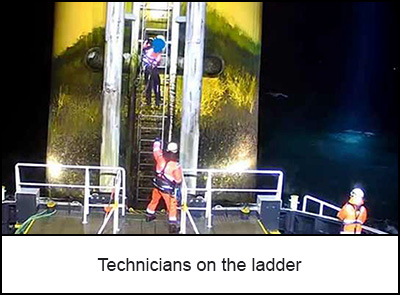-
What happened?
Vessels were delayed from sailing due to lightning risks. After the lightning had passed, the work could be scheduled.
The amber sail status was highlighted by the launch tool (weather forecasting system) and an amber safety brief was held with key stakeholders.
The amber safety brief failed to highlight a key safety restriction of the amber status, being that no transfers are permitted to take place during hours of darkness.
Three vessels left the port facility and transited to windfarms. Vessels transferred personnel to the wind turbine generator (WTG) while the sun was setting.
The weather deteriorated faster than expected, prompting the work to stop.
After the sun had set, the technicians transferred down the ladder and removed the self-retracting lanyard (SRL) from their harness, effectively free climbing the last section of ladder believing this to be the safest option given the uncontrolled movement of the vessel in the sea conditions.

-
Why did it happen?
Vital information (e.g. restricting hours of darkness transfers) was omitted from the amber safety brief and no records of attendees or topics of discussion was recorded.
Enforcement of the ‘hours of darkness’ transfer rule was not enforced.
Personnel openly stated it was not an uncommon occurrence to transfer in rough weather during the hours of darkness and not removing their personal protective equipment (PPE).

-
What did they learn?
Technicians should be removed from offshore assets before the hours of darkness.
Ensure the scheduled workload is achievable in the hours of daylight available.
Ensure that site personnel at all levels are aware of and understand the transfer procedure.
Ensure that personnel are aware of when a transfer is considered unsafe and encourage unsafe transfers being intervened and stopped.
Adhere to the guidelines outlined in the guide most relevant to the job being done.
Ensure all pertinent information is included in safety briefings without omission.

-
Ask yourself or your crew
How can we ensure that safety briefings include all relevant information, especially regarding instructions during adverse conditions?
What measures can we implement to enforce safety rules effectively, even in challenging operational environments?
How can we foster a culture where personnel feel empowered to speak up and intervene in unsafe situations?
What steps can we take to improve the adoption of safety tools and procedures across all levels of the organisation?
How can we better integrate workload planning with safety considerations to ensure safe and efficient operations?

Add to homescreen
Content name
Select existing category:
Content name
New collection
Edit collection
What happened?
Vessels were delayed from sailing due to lightning risks. After the lightning had passed, the work could be scheduled.
The amber sail status was highlighted by the launch tool (weather forecasting system) and an amber safety brief was held with key stakeholders.
The amber safety brief failed to highlight a key safety restriction of the amber status, being that no transfers are permitted to take place during hours of darkness.
Three vessels left the port facility and transited to windfarms. Vessels transferred personnel to the wind turbine generator (WTG) while the sun was setting.
The weather deteriorated faster than expected, prompting the work to stop.
After the sun had set, the technicians transferred down the ladder and removed the self-retracting lanyard (SRL) from their harness, effectively free climbing the last section of ladder believing this to be the safest option given the uncontrolled movement of the vessel in the sea conditions.

Why did it happen?
Vital information (e.g. restricting hours of darkness transfers) was omitted from the amber safety brief and no records of attendees or topics of discussion was recorded.
Enforcement of the ‘hours of darkness’ transfer rule was not enforced.
Personnel openly stated it was not an uncommon occurrence to transfer in rough weather during the hours of darkness and not removing their personal protective equipment (PPE).
What did they learn?
Technicians should be removed from offshore assets before the hours of darkness.
Ensure the scheduled workload is achievable in the hours of daylight available.
Ensure that site personnel at all levels are aware of and understand the transfer procedure.
Ensure that personnel are aware of when a transfer is considered unsafe and encourage unsafe transfers being intervened and stopped.
Adhere to the guidelines outlined in the guide most relevant to the job being done.
Ensure all pertinent information is included in safety briefings without omission.
Ask yourself or your crew
How can we ensure that safety briefings include all relevant information, especially regarding instructions during adverse conditions?
What measures can we implement to enforce safety rules effectively, even in challenging operational environments?
How can we foster a culture where personnel feel empowered to speak up and intervene in unsafe situations?
What steps can we take to improve the adoption of safety tools and procedures across all levels of the organisation?
How can we better integrate workload planning with safety considerations to ensure safe and efficient operations?
Three vessels transferred personnel to windfarms after the sun had set and the weather deteriorated faster than expected. The technicians effectively had to free climb down the last section of the ladder, believing this to be the safest option given the uncontrolled movement of the vessel in the sea conditions.













